- This means you will need a late 2015 iMac 27-inch or newer, 2016 MacBook Pro or newer, 2018 Mac Mini, 2019 Mac Pro, 2018 MacBook Air, or an early 2016 MacBook or newer model computer.
- The Mac finally has a true dark mode thanks to macOS Mojave. Just toggle it in your.
- How to Install Windows 10 Drivers on Mac OS? To install Windows 10 Drivers on Mac OS, First, download the Bootcamp software from the link above. Now, wait for some minutes, then the Windows will be installed on your Mac computer. Copy the Bootcamp software that you have to download on the first step of this article.

This content has been archived, and is no longer maintained by Indiana University. Information here may no longer be accurate, and links may no longer be available or reliable.
Spring-loaded folders are a feature of the Finder that allow you to move through a hierarchical listing of folders with greater ease. They are especially useful if you wish to move a file, application, or even another folder, into a folder deeply nested within severalother folders. For example, you could use the feature to quickly movean Adobe Photoshopplug-in into thePlug-ins folder, which is nested within theAdobe Photoshop folder, which in turn is nested within theApplications folder, which is at the top level of yourhard disk. Below is an example of how to move aPhotoshop plug-in to the Plug-ins folder:
- Click and drag the plug-in's icon over the hard disk icon, but donot release the mouse button. The hard disk'sicon will flash and then open.
- Again, without releasing the mouse button, movethe mouse pointer over the
Applicationsfolder. TheApplicationsfolder will open. - Repeat the process with the
Adobe Photoshopfolder andPlug-insfolder. - When the
Plug-insfolder opens, release the mousebutton; the plug-in will be moved into that folder. Also, the higher level folders will all close, leaving thePlug-insfolderas the only open window within that folder hierarchy.
Original restore disc media that was provided in the box with a new Power Mac G5 computer. The medieval plague mac os. Power Mac G5 (Late 2004) - Mac OS X 10.3.5: 691-5202-A (Install Disc 1) - suitable for expanding and burning to DVD.
Use similar steps to move other files into different folders. Ifyou mistakenly open the wrong folder (for example, you opened theAdobe Reader folder instead of the Adobe Photoshopfolder), you can close it by moving your mouse pointer out of theopen window back into a parent window. Or, to close all nestedfolders, move the pointer so it is not over any window.
To modify how spring-loaded folders work, from the Finder'sFinder menu, select Preferences... To turn spring-loaded folders on or off, next to Spring-loaded folders and windows, check the box. Here you can also change how long the folders delay before springing open.
Is your Mac up to date with the latest version of the Mac operating system? Is it using the version required by a product that you want to use with your Mac? Which versions are earlier (older) or later (newer, more recent)? To find out, learn which version is installed now.
If your macOS isn't up to date, you may be able to update to a later version.
Which macOS version is installed?
Spring Thing 2018 Mac Os X
Cool beach cool mac os. From the Apple menu in the corner of your screen, choose About This Mac. You should see the macOS name, such as macOS Big Sur, followed by its version number. If you need to know the build number as well, click the version number to see it.
Spring Thing 2018 Mac Os Downloads
Which macOS version is the latest?
These are all Mac operating systems, starting with the most recent. When a major new macOS is released, it gets a new name, such as macOS Big Sur. As updates that change the macOS version number become available, this article is updated to show the latest version of that macOS.
If your Mac is using an earlier version of any Mac operating system, you should install the latest Apple software updates, which can include important security updates and updates for the apps that are installed by macOS, such as Safari, Books, Messages, Mail, Music, Calendar, and Photos.
Spring Thing 2018 Mac Os Download
| macOS | Latest version |
|---|---|
| macOS Big Sur | 11.3 |
| macOS Catalina | 10.15.7 |
| macOS Mojave | 10.14.6 |
| macOS High Sierra | 10.13.6 |
| macOS Sierra | 10.12.6 |
| OS X El Capitan | 10.11.6 |
| OS X Yosemite | 10.10.5 |
| OS X Mavericks | 10.9.5 |
| OS X Mountain Lion | 10.8.5 |
| OS X Lion | 10.7.5 |
| Mac OS X Snow Leopard | 10.6.8 |
| Mac OS X Leopard | 10.5.8 |
| Mac OS X Tiger | 10.4.11 |
| Mac OS X Panther | 10.3.9 |
| Mac OS X Jaguar | 10.2.8 |
| Mac OS X Puma | 10.1.5 |
| Mac OS X Cheetah | 10.0.4 |